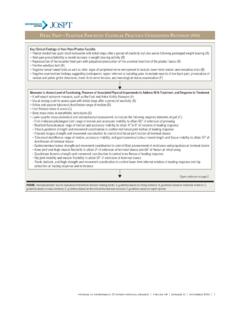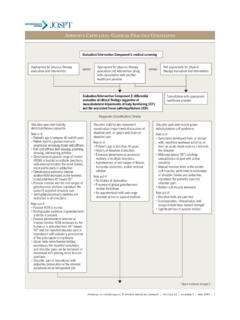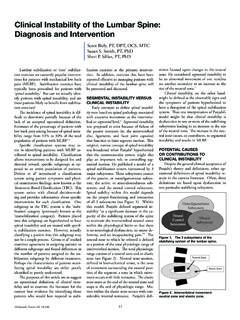Transcription of Clinical Practice Guidelines - Academy of Orthopaedic ...
1 Clinical Practice GuidelinesDAVID S. LOGERSTEDT, PT, PhD DAVID SCALZITTI, PT, PhD MAY ARNA RISBERG, PT, PhDLARS ENGEBRETSEN, MD KATE E. WEBSTER, PhD JULIAN FELLER, MD LYNN SNYDER-MACKLER, PT, ScD MICHAEL J. AXE, MD CHRISTINE M. MCDONOUGH, PT, PhDKnee Stability and Movement Coordination Impairments: knee Ligament Sprain Revision 2017 Clinical Practice Guidelines Linked to the International Classification of Functioning, Disability and Health From the Orthopaedic Section of the American Physical Therapy AssociationJ Orthop Sports Phys Ther.
2 2017;47(11):A1-A47. : Roy D. Altman, MD Paul Beattie, PT, PhD John DeWitt, DPT James M. Elliott, PT, PhD Amanda Ferland, DPTG. Kelley Fitzgerald, PT, PhD Sandra Kaplan, PT, PhD David Killoran, PhD Joanna Kvist, PT, PhD Robert Marx, MD, MScLeslie Torburn, DPT James Zachazewski, DPTFor author, coordinator, contributor, and reviewer affiliations, see end of text. 2017 Orthopaedic Section, American Physical Therapy Association (APTA), Inc, and the Journal of Orthopaedic & Sports Physical Therapy.
3 The Orthopaedic Section, APTA, Inc, and the Journal of Orthopaedic & Sports Physical Therapy consent to the reproduction and distribution of this guideline for educational purposes. Address correspondence to Brenda Johnson, ICF-Based Clinical Practice Guidelines Coordinator, Orthopaedic Section, APTA, Inc, 2920 East Avenue South, Suite 200, La Crosse, WI 54601. E-mail: OF RECOMMENDATIONS ..A4 Clinical Guidelines : Impairment/Function-Based Diagnosis ..A7 Clinical Guidelines : Examination ..A17 Clinical Guidelines : Interventions.
4 A22 AUTHOR/REVIEWER AFFILIATIONS AND CONTACTS ..A25 REFERENCES ..A2647-11 CPG knee 110/18/2017 2:26:08 PM Journal of Orthopaedic & Sports Physical Therapy Downloaded from at on November 3, 2017. For personal use only. No other uses without permission. Copyright 2017 Journal of Orthopaedic & Sports Physical Therapy . All rights Ligament Sprain: Clinical Practice Guidelines Revision 2017a2 | november 2017 | volume 47 | number 11 | journal of Orthopaedic & sports physical therapyDIAGNOSIS/CLASSIFICATIONAP hysical therapists should diagnose the International Classi-fication of Diseases (ICD)
5 Categories of Sprain and strain in-volving collateral ligament of knee , Sprain and strain involving cruciate ligament of knee , and Injury to multiple structures of knee , and the associated International Classification of Functioning, Dis-ability and Health (ICF) impairment-based categories of knee insta-bility (b7150 Stability of a single joint) and movement coordination impairments (b7601 Control of complex voluntary movements), us-ing the following history and physical examination findings: mecha-nism of injury, passive knee laxity, joint pain, joint effusion, and movement coordination DIAGNOSISBThe clinician should suspect diagnostic classifications asso-ciated with serious pathological conditions when the individ-ual s reported activity limitations and impairments of body function and structure are not consistent with those presented in the Diagno-sis/Classification section of this guideline.
6 Or when the individual s symptoms are not resolving with intervention aimed at normalization of the individual s impairments of body OUTCOME MEASURES: activity LIMITATIONS AND SELF-REPORTED MEASURESBC linicians should use the International knee Documentation Committee 2000 Subjective knee Evaluation Form (IKDC 2000) or knee injury and Osteoarthritis Outcome Score (KOOS), and may use the lysholm scale , as validated patient-reported outcome measures to assess knee symptoms and function, and should use the Tegner activity scale or Marx activity Rating scale to assess ac- tivity level, before and after interventions intended to alleviate the physical impairments, activity limitations, and participation restric-tions associated with knee ligament sprain.
7 Clinicians may use the Anterior Cruciate Ligament-Return to Sport after Injury (ACL-RSI) in-strument as a validated patient-reported outcome measure to assess psychological factors that may hinder return to sports before and af-ter interventions intended to alleviate fear of reinjury associated with knee ligament PHYSICAL PERFORMANCE MEASURESBC linicians should administer appropriate Clinical or field tests, such as single-legged hop tests (eg, single hop for distance, crossover hop for distance, triple hop for distance, and 6-meter timed hop)
8 , that can identify a patient s baseline status rela-tive to pain, function, and disability; detect side-to-side asymmetries; assess global knee function; determine a patient s readiness to return to activities; and monitor changes in the patient s status throughout the course of PHYSICAL IMPAIRMENT MEASURESBWhen evaluating a patient with ligament sprain over an epi-sode of care, clinicians should use assessments of impair-ment of body structure and function, including measures of knee laxity/stability, lower-limb movement coordination, thigh muscle strength, knee effusion.
9 And knee joint range of CONTINUOUS PASSIVE MOTIONCC linicians may use continuous passive motion in the immedi-ate postoperative period to decrease postoperative pain after anterior cruciate ligament (ACL) EARLY WEIGHT BEARINGCC linicians may implement early weight bearing as tolerated (within 1 week after surgery) for patients after ACL knee BRACINGCC linicians may use functional knee bracing in patients with ACL should elicit and document patient preferences in the decision to use functional knee bracing following ACL reconstruction, as evidence exists for and against its may use appropriate knee bracing for patients with acute posterior cruciate ligament (PCL) injuries, severe medi-al collateral ligament (MCL) injuries, or posterolateral corner (PLC)
10 IMMEDIATE VERSUS DELAYED MOBILIZATIONBC linicians should use immediate mobilization (within 1 week) after ACL reconstruction to increase joint range of motion, reduce joint pain, and reduce the risk of adverse responses of sur-rounding soft tissue structures, such as those associated with knee extension range-of-motion CRYOTHERAPYBC linicians should use cryotherapy immediately after ACL reconstruction to reduce postoperative knee SUPERVISED REHABILITATIONBC linicians should use exercises as part of the in-clinic super-vised rehabilitation program after ACL reconstruction and should provide and supervise the progression of a home-based exer-cise program.






